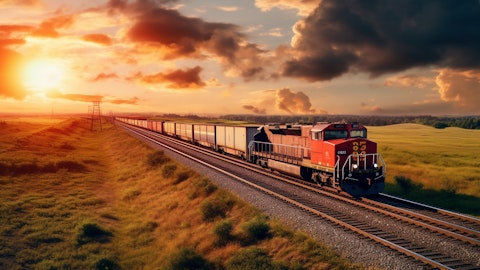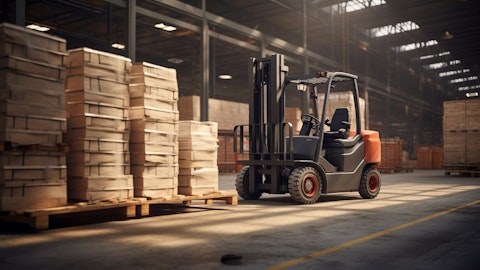Kevin Boone: I just want to tell you guys a little story because I get often asked all the time, what are the benefits of ONE CSX and the culture we’re trying to achieve here. Within two days of the incident in Baltimore, we put out a request for transfers from our engineers and conductors, who were in our locations to be able to relocate temporarily for a couple of months to help with the change in the train setup and schedule we needed to support the movement of coal elsewhere. And we needed maybe a dozen people to go, and we had seven, eight times that people immediately sign up to help. And that’s a testament to what we’re seeing here is that our people are willing to be a part of the solution and to serve our customers and know how important that is.
And that’s just a great example. So there’s a little bit of cost of that relocation and a temporary transfer. But I can tell you, a little over a year ago, we were trying to get temporary transfers, and we struggled. And this time, we have so many people signed up, it was great to see. And those are the signs you want to see of a healthy culture and people are really service oriented, but also understand the bigger picture of what we’re trying to do here in serving our customers. And so we have not been the constraint or the bottleneck at all. In fact, we’ve been able to really — Kevin and I were with one of our largest coal customers the other day and he was just so proud of the work we’ve done and our team has done to respond so quickly and be able to react, and that’s a testament to our people.
That’s just another example of why it’s so important to stay consistently focused on our culture and our people and help them understand that we’re here to serve customers, and that’s why we exist to do it safely, obviously, and efficiently, but that message is resonating and our people are responding.
Mike Cory: And just one more point, Ben, I should mention this is. With this issue, we’ve been able to get a betterment in terms of our maintenance at Curtis Bay. We’ve been able to go in there and do work that we would have had to do it under load with a lot of volume moving through. So we’ve fully taken advantage of some pretty major restoration that we were able to accomplish that we’re still working on. So that’s been a good thing.
Operator: Your next question comes from Amit Mehrotra with Deutsche Bank. Please go ahead.
Amit Mehrotra: Great. Thanks for taking the question. Sean, I just wanted to clarify one quick thing. I think in response to the first question, regarding 1Q to 2Q, you said profits up. I don’t know if you said margins up. You may have said it, but I didn’t catch it. Just want to clarify by that point. And then, Kevin, I just wanted to talk about interchange. So I think before — unless I’m mistaken, maybe you interchange half your volumes. Any — is that mostly evenly split between the two West Coast rails or I’m just trying to understand how much do you actually interchange with UP? And what proportion of kind of that interchange — total interchange is actually represented by the EP? Thank you.
Sean Pelkey: Amit, it’s Sean. I’ll take the first part. Yeah, profit up Q2 versus Q1 and margins up. I think that’s a fair expectation on both sides.
Kevin Boone: Look, I think we said roughly half of our business touches another railroad. And certainly, when you look at the Western railroads, particularly UP, they are a very large part of that. So they’re a very important partner to us. All of our partners are very important. So it’s encouraging to hearing a lot of signs to go after more business, and we’re working collaboratively to do that. So a lot of opportunities out there that we see.
Operator: Your next question comes from Walter Spracklin with RBC Capital Markets. Please go ahead.
Walter Spracklin: Yeah. Thanks very much. Good afternoon, everyone. Sean, when I’m comparing your outlook, and I know your outlook is unchanged from prior. When I look at your — what — some of your commentary regarding the moving parts that have occurred in the first quarter and looking into the rest of the year, you did have a little bit of a tougher January. Mike pointed to some operating measures that aren’t where we want them to be. You’ve got a worse coal market, there was a Baltimore outage. Trucking is worse but you maintain your guidance. So I’m just curious as to what — if those are the puts, what are the takes in terms of what’s the offset here to maintain your guidance despite kind of those headwinds that emerged a little bit here so far in 2024?
Sean Pelkey: Yeah, Walter, I’ll do my best on that one. So yeah, I mean, certainly, a little bit of winter in January, couple of things there. And then, of course, the Baltimore outage was unexpected, and that’s a hit to the forecast. But still feel very confident about what the second half looks like, in particular, from a volume and revenue perspective and what it looks like on the cost side. We did an exercise here where we looked at every dollar of every budget and there’s a lot of small wins that we’re getting here, just $1 million, $2 million here and there across every line item, both within operations and across the business. So I think it’s everybody focused on how do we deliver the kind of economic financial performance that sort of backs up all the momentum that we’ve got with ONE CSX, the goodwill that we’ve got with the customer.
And to the extent there’s revenue headwinds, how do we close the gap on some of those, but still a lot of confidence, I think, from the CSX team.
Operator: Your next question comes from Stephanie Moore with Jefferies. Please go ahead.
Stephanie Moore: Hi, good afternoon, thank you. I wanted to maybe switch gears a little bit and talk about maybe capital allocation and maybe your focus on share repurchases, have seen it kind of come down a little bit over the last couple of quarters. So I just wanted to gauge your appetite in terms of incremental share repurchases as the year progresses. Thanks.
Sean Pelkey: Thanks, Stephanie. It’s Sean. We’re still committed to the share repurchase as well as the dividend. It’s certainly a step down in the first quarter of the year, but we — the stock ran up pretty quickly. And so we try to be opportunistic and gauge the amount of buybacks that we do based on the momentum in the stock. So with the pullback that we’ve had recently, we’re buying a little bit more. Still committed to do a significant amount of share repurchases this year. It will be a little bit less than it was last year, just simply because we came into the year with a little bit less cash on the balance sheet. And last year, we raised a little bit of incremental debt to help juice the system, and that led to some additional buybacks, but we’re still very committed to that, and you’ll see it go up and down quarter-to-quarter just based on the opportunity that we have in the market.
Operator: Your next question comes from Ravi Shanker with Morgan Stanley. Please go ahead.
Ravi Shanker: Thanks. Good afternoon, everyone. So, a two-parter here on the ports. One just on Baltimore, a follow-up. I think you’ve said you redirected about 33% of the traffic so far. Does that mean there’s going to be like pent-up demand when the channel is kind of normalized in 3Q or late 2Q and beyond? Just wanted to confirm that. And also on the East Coast to West Coast kind of share shift, kind of what innings are we kind of on the normalization there? And are you hearing from your customers ahead of labor talks on the East Coast ports and maybe any preparations there? Thank you.
Kevin Boone: Yeah. Look, in terms of pent-up demand, there’s outages in the summer that happened for the coal miners and we’ll see how they handle that with some of the obviously, slowdown that we’ve seen. Is there opportunity to make up to this volume in the third and fourth quarter? There is. That’s not in the plan right now, but we’ll see how that plays out. The prices remain strong. I’m sure there’s going to be a lot of incentive to meet those contractual obligations and those things. On the East Coast, West Coast, look, if you’ve been to Savannah lately, there’s huge, huge investments going on in investments. Obviously, when you’re spending billions of dollars, you’ve got to have visibility to the demand out there and — there’s tremendous demand that they see coming.
And we’re not hearing any anticipation of significant trade moving from the east to west. Obviously, if that happened and they want to move to the East, there could be a net benefit to us. So I think from our perspective, it’s probably a neutral outcome if that happened. And in some cases, you could see some business that normally would come into the ports and move truck that would come over the less than move over our railroad, which would be an incremental opportunity for us. So I don’t see a high probability to risk there, maybe some more opportunities if that happens, but we’ll continue to watch it. But over the long term, we see a lot of capacity growth in the East, and it’s just not there in the West.
Operator: Your next question comes from David Vernon with Bernstein Research. Please go ahead.
JD Millan: Thank you for taking the question. This is JD Millan for David Vernon. I guess, Kevin, going back to the question on the 10x opportunity, can you give us some more color on what is driving this massive tenfold increase? Is it just traffic coming on from the highway in [indiscernible], or is it more of an increase on the efforts from your team? Just a little bit of color on that would be helpful. Thank you.
Kevin Boone: I think generally, there’s a lot of geopolitical risk out there. There’s a lot of movement in terms of how companies post the pandemic are thinking about their supply chains. And we talked about this before, but a supply — their supply chains are being viewed as competitive advantages and being closer to your end consumer, which we have the most valuable consumers in our network in the world, it’s becoming a priority, and we’re seeing those investments take place to really happen. So it’s broad based, as I mentioned, a lot of activity, but I think that’s the major draw. I think they saw through the pandemic, a lot of disruption with how much it costs to get things delivered to the end consumers. So now it provides an opportunity where we can maybe get the inbound and the outbound, which is pretty exciting for us.
So it will happen over time. There’s already a lot of capital on the ground, a lot of the capital that’s already been spent. So we’ll participate in that. But it’s a really shift from what we’ve seen probably over the last three or four decades, in terms of activity. And rather than the industrial base decaying within our network, we see some growth in that industrial base, which should benefit us over time.
Operator: Your next question comes from Jeff Kauffman with Vertical Research Partners. Please go ahead.
Jeff Kauffman: Thank you very much. And our thoughts are with the Foote family as well, just a terrific guy. I want to go back to Bascome’s question on any nervousness with customers using other rails, given all the media and the hype, maybe not so much in terms of customer wins, but at this point, what types of questions or what types of concerns are being raised to you? And is there an anxiety among the customer base?
Kevin Boone: Look, I mean, I’ve seen more activity with our customers willing us to share us their truck files to really open up the book in terms of what their supply chain looks like, given some of the service performance we’ve been able to achieve over the last few quarters. So that’s exciting for us. We’re really looking internally about what we can deliver. I think customers want certainty and they want visibility. And I think we’re providing that. They understand the path we’re on. They’re supportive of that path, and they’re seeing the service along with it. So we had many customers last year, say, hey, we want to see the service and then we can talk about more opportunities for you. And now we’re in the midst of a lot of those discussions, and it’s — the team is working really hard.
The backdrop, the wind is not at our back. Clearly, we have a lot of markets that are at cyclical lows. Those will come back. But the opportunity right now is to win wallet share. And as you win wallet share and the markets turn, that would translate into a lot of growth for us. So incredibly excited. We’re internally focused on what we can accomplish those discussions, what we can deliver. And I think we’re having a lot of those conversations.
Joe Hinrichs: And Joe, Kevin and I have — sorry, Kevin and I have spent, I don’t know how many customers we’ve met with in the last couple of months, but we’ve had an FDA and a number of other events. I think we’ve touched almost every major customer we have and directly personally. And we’ve seen a lot of — gotten a lot of feedback on the consistency, reliability and the continuity of our messaging and also our actions. And that’s what customers want, having been on for decades myself just want to have reliability and they want constancy of purpose. They want to know what you stand for is you’re going to deliver it. And that’s what we’re starting to show, and as Kevin said, our customer is starting to trust us again, which is the foundation for us to be able to grow with them as from the trust us, and that’s the trust we want to keep delivering and building and gaining because of the constancy of what we’re standing for, which is, of course, — we’re going to engage our employees with ONE CSX to serve our customers better and do that with better safety.
The efficiency will come from the actions that we teach and what we do. And so we’re going to stay on that course and it’s delivering for us, and you saw it in the first quarter, and you’ll see it again next quarter.
Operator: This will conclude our question-and-answer session. And that does conclude today’s conference. Thank you all for your participation. You may now disconnect.
Follow Csx Corp (NASDAQ:CSX)
Follow Csx Corp (NASDAQ:CSX)
Receive real-time insider trading and news alerts





